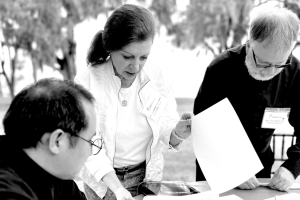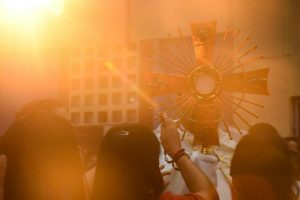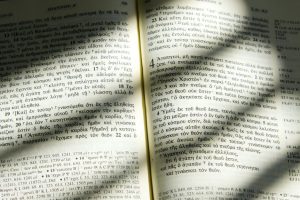In his homily on the morning of May 7, at the votive Mass of the Holy Spirit before the papal conclave began, Cardinal Giovanni Battista Re, dean of the College of Cardinals, preached on Acts of the Apostles 1:14, when the disciples and Mary, Mother of God, gathered together to pray and wait for the Holy Spirit’s descent after Christ’s ascension into heaven.
“This is precisely what we are doing a few hours before the beginning of the conclave, under the gaze of Our Lady beside the altar, in this basilica which rises above the tomb of the Apostle Peter,” said Re.
This conclave is the largest in history, with 133 cardinals out of the 135 eligible cardinal electors participating.
“We are here to invoke the help of the Holy Spirit, to implore his light and strength so that the pope elected may be he whom the church and humanity need at this difficult and complex turning point in history,” Re said, noting that the cardinal electors were about to “undertake an act of the highest human and ecclesial responsibility and to make a choice of exceptional importance.”
In that light, Re encouraged his fellow cardinals to put aside every “personal consideration” and make their decisions through considering “only the God of Jesus Christ and the good of the Church and of humanity.”
Re invoked Pope Paul VI’s call to build a “civilization of love.” He also emphasized the call of the eucharist they were celebrating to love and communion with one another.
“Among the tasks of every successor of Peter is that of fostering communion: communion of all Christians with Christ; communion of the bishops with the pope; communion of the bishops among themselves,” Re said.
Re’s message of communion and unity was preached to the most geographically diverse College of Cardinals in history. The European contingent of cardinals remains the highest number among the continents, and Italy is still the country boasting the highest number of cardinal electors—17. Other continents’ representation, however, outweighs Italy’s historic ascendancy—there are 23 cardinal electors from the Asian continent, 18 from Africa, and 37 from the Americas.
“The unity of the church is willed by Christ; a unity that does not mean uniformity, but a firm and profound communion in diversity,” Re said, adding “provided that full fidelity to the gospel is maintained.”
Re reminded the cardinals that the choice of the Sistine Chapel, with its impressive fresco of the Last Judgment, was by design: that their actions were taking place in the sight of God and would be weighed by the divine judge.
“Let us pray, then, that the Holy Spirit, who in the last hundred years has given us a series of truly holy and great pontiffs, will give us a new pope according to God’s heart for the good of the church and of humanity,” he concluded.
Later that afternoon, at 4:30 p.m., the cardinals processed into the Sistine Chapel, and crowds gathered in St. Peter’s Square to watch on livestream. As the cardinal electors processed from Pauline Chapel to the Sistine Chapel, pilgrim groups continued to process through St. Peter’s Square to the Holy Door in honor of the Jubilee Year.
Crowds ringed the square, some chanting along in Latin as the choir sang the litany of the saints. This was the first conclave that St. Popes Paul VI, John Paul II, and John XXIII were invoked.
When all the cardinals reached the Sistine Chapel, they sang Veni Creator Spiritus—“Come Holy Spirit.”
“No matter your religion, if you’re a spiritual person, you can sense the Holy Spirit here,” Jerry Navarette, one of the members of the crowd in St. Peter’s Square, said.
“I feel a presence here. I feel alive, relaxed,” his wife, Dana Navarrette, said, trying to describe the emotions the scene evoked.
The couple, from the Dallas-Fort Worth area of Texas, was visiting Italy to celebrate their 25th wedding anniversary. In their late 40s, they were married in the Catholic Church but now identified as nondenominational Christians.
“It’s a blessing to be here,” Jerry Navarrette said, “short of being in Jerusalem, this is the holiest place to be.” The couple were sending videos and updates to their son, who converted to Catholicism when he got married. He had been in Rome just six weeks before. They found the experience moving and intriguing.
Dana Navarrette said they had visited Pope Francis’ tomb in the Basilica of Saint Mary Major in Rome earlier in the week. She found the simplicity of Francis’ pastoral style, up until his final resting place, “humbling.”
Marilis Pineiro, who was also in the square that afternoon,had a personal connection with Pope Francis. She worked in Vatican diplomacy in Rome and at the Vatican Embassy in Washington, D.C., when she was a sister in a Franciscan Order. As part of that work, she got to work with Pope Francis directly during his Apostolic Visit to the United States in 2015.
Pineiro worked at the Vatican Secretariat of State during Pope Francis’ tenure. “He was so gentle, so kind,” she said of meeting Pope Francis. She now works as an independent consultant, specializing in diplomacy, and has a healthy Instagram following (@exnunontherun) where she blogs about her faith, her life in Italy and, now, her experience at the conclave. She said it felt so important to be present for the conclave, and the experience felt momentous. “It’s so prayerful and so solemn,” she said. “it’s not just another election.”
The 32-year-old diplomat brought Romeo—her 2-year-old Yorkie-mix recue pup—with her, dressed as “Pup John Paul II,” attracting the attention of plenty of news cameras and the admiration of the surrounding crowd. “We’re overstimulated,” she said, as the crowds were departing from the square, after Cantalamessa Diego Ravelli declared, “Extra omnes,”—Latin for “everyone, leave.”
Several hours later, at 8:45 p.m. Rome time, smoke had not yet appeared from the chimney.
Some commenters in the crowd speculated about technical issues, while others noted the larger numbers of cardinals than in previous conclaves. The number of voting cardinals was significantly more than the 115 cardinal electors in the 2013 and 2005 conclaves, and several times more than the 51 that voted in the last conclave that lasted more than three days—Cardinal Angelo Roncalli’s election as John XXIII in 1958.
The crowd spilled out of St. Peter’s Square as they craned their necks to watch the small smokestack. The crowd appeared much larger than the first night of attendees at the last conclave in 2013. Occasionally, rounds of applause and small choruses of broke out—false alarms, impatience to see something, or perhaps light-hearted cheering of the seagull messengers that circled the Sistine Chapel smokestack.
Finally, after a suspenseful glitch during which the screens in St. Peter’s Square went black—“It was so dramatic,” said Pineiro—the crowd was rewarded at 9 p.m. Rome time with smoke billowing from the chimney. It’s color? Like the screens: black.
Image: Courtesy of Renee Roden












Add comment